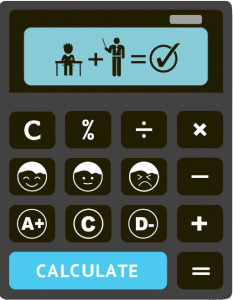Functions build the foundations of your knowledge of Calculus. This article will discuss everything you need to know to start learning about functions.
Learning Outcomes
After reading this article, you should be able to understand the following topics from your year 11 maths curriculum related to functions:
- Types of relations and which of those constitute a function
- Function notation and the interval notation
- Domain and range of a function
- Vertical line test
What’s a Function?
To understand a function, we need to take a step back and first understand what a relation is. After all, a function is a particular type of relation.
In life, a relationship is a connection between two objects or people. For example, we could have a relation between a set of fathers and a set of sons, a relation between a set of moms and a set of daughters, a relation between a set of cars and a set of car owners, and so on. By the way, what’s a ‘set’?
A set is a collection of related objects. We can have a set of books, a set of difficult-to-pronounce words, a set of prime numbers less than 100, and so on. It’s denoted with a pair of the second bracket with the set elements, separated by commas, enlisted inside them. For example, the set of positive even numbers less than 15 is denoted as {2, 4, 6, 8, 10, 12, 14}
In maths, a relation is a set of ordered pairs. A relation, also being a set, can look like {(1, 4), (2, 9), (3, 16), (4, 25)}. It’s called an ordered pair because the order in which you write the numbers (or object names) matters. (1, 4) is different from (4, 1). Why?
Take, for instance, the “father-son” relation. (Steve, Nathan) would mean Steve is the dad and Nathan is the son. If we swap the names and write (Nathan, Steve), that would mean Nathan is Steve’s dad, which isn’t the case here! The first element of each pair belongs to one set (let’s call that set A), and the second element belongs to another set (let’s call that set B). We can denote a relation using an ‘arrow diagram’, as shown below.

Depending on the way the elements in the two sets are connected, a relationship can be one of the following:
- One-to-one: Each element from set A is related to exactly one element from set B. The figure above shows a one-to-one relationship.
- One-to-many: At least one element from set A is related to more than one element from set B.
- Many-to-one: At least one element from set B is related to more than one element from set A.
- Many-to-many: A combination of one-to-many and many-to-one, as shown in the figure below.

For a relationship to be a function, it has to be either one-to-one or many-to-one. In other words, an element from set A can, at most, be related to only one element from set B. Further, a function is not a random relationship between the elements of two sets. It follows a definite rule (called its equation). It takes an input (called x, which belongs to set A) and applies the rule on it to produce an output (called y, which belongs to set B). This is shown in the figure below.
Function Notation
In function notation, we replace y with f(x). Referring to the figure above, we write f(1) = 1, f(4) = 16, f(6) = 36, and so on.
Domain and Range
The domain of a function is the set of values the input, x, can have, and the range is the set of values the output, y, can have. Can x and y NOT have specific values?
Yes, and the allowed values depend on the function rule.
Take, for instance, the function \(f(x)=x^2\) As the square of a number can’t be negative, the range of this function is [0, ∞). This is called interval notation, where square brackets indicate the boundary value is included, and the first brackets indicate the boundary value is excluded. As infinity is not a ‘number’, it can’t be included.
Likewise, the domain of the function \(g(x)=√x\) is [0, ∞). Why?
Do you need personalized help to prepare for your Year 11 HSC Maths exam? Contact us today!
Vertical Line Test
As a function maps a set of ‘x’ values to a set of ‘y’ values, they can be plotted in an x-y coordinate plane. Once we connect all such points with a smooth curve, we get the function’s graph.
As we discussed above, an x value can, at most have one y value for a graph to be a function. To test if a graph is a function or not, we draw vertical lines at different points. The point is (pun intended 😉), if we can find a vertical line that crosses the graph at more than one point, it means that the x value has more than one y value. Therefore, such a graph is not a function.
The figures below will help you understand this concept.
Wrap Up
Functions are used in many real-world applications, from mathematics and engineering to biology and business. They can be used to perform a wide range of calculations or execute specific tasks, making them an essential tool for anyone working in these fields. Be sure you have a good grasp of this topic, as it forms the gateway to Calculus, a significant chunk of your year 11 HSC Maths syllabus.








